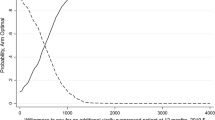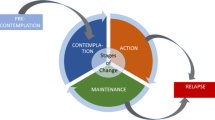Abstract
The HIV/AIDS epidemic can be eliminated if 73% of people living with HIV take antiretroviral medications and achieve undetectable viral loads. This study assessed the effects of financial incentives in suppressing viral load. People living with HIV with detectable viral loads (N = 102) were randomly assigned to Usual Care or Incentive groups. Incentive participants earned up to $10 per day for 2 years for providing blood samples that showed either reduced or undetectable viral loads. This report presents data on the 1st year after random assignment. Incentive participants provided more (adjusted OR = 15.6, CI 4.2–58.8, p < 0.001) blood samples at 3-month assessments with undetectable viral load (72.1%) than usual care control participants (39.0%). We collected most blood samples. The study showed that incentives can substantially increase undetectable viral loads in people living with HIV. Financial incentives for suppressed viral loads could contribute to the eradication of the HIV/AIDS epidemic.
Resumen
La epidemia de VIH/SIDA podría ser eliminada si el 73% de las personas que viven con VIH tomaran medicamentos antirretrovirales y lograran mantener la carga viral indetectable. Este estudio evaluó el efecto de incentivos económicos sobre la supresión de la carga viral. Personas que viven con VIH cuyas cargas virales estaban detectables (N = 102) fueron asignadas aleatoriamente a recibir atención de rutina o incentivos. Los participantes en el grupo de incentivos podían recibir hasta $10 por día durante dos años si sus muestras de sangre demostaban que la carga viral se había reducido o estaba indetectable. Este informe presenta datos sobre el primer año después de la asignación al azar. Los participantes en el grupo de incentivos proporcionaron más (proporción de probablidades ajustadas = 15.6, CI 4.2-58.8, p < 0.001) muestras cada tres meses con cargas virales indetectables (72.1%) que los participantes que recibieron cuidados de rutina (39.0%). Hemos recolectado la mayoría de las muestras de sangre. El estudio demostró que los incentivos pueden aumentar sustancialmente las cargas virales indetectables en personas que viven con VIH. Los incentivos económicos por mantener la carga viral suprimida podrían contribuir a la erradicación del VIH/SIDA.



Similar content being viewed by others
References
Montaner JS, Wood E, Kerr T, et al. Expanded highly active antiretroviral therapy coverage among HIV-positive drug users to improve individual and public health outcomes. J Acquir Immune Defic Syndr. 2010;55(Suppl 1):5.
Eisinger RW, Dieffenbach CW, Fauci AS. HIV viral load and transmissibility of HIV infection: undetectable equals untransmittable. JAMA. 2019;321(5):451–2.
Kay ES, Batey DS, Mugavero MJ. The HIV treatment cascade and care continuum: updates, goals, and recommendations for the future. AIDS Res Ther. 2016;13:35 eCollection.
Baltimore metro annual HIV epidemiological profile 2016. https://phpa.health.maryland.gov/OIDEOR/CHSE/SiteAssets/Pages/statistics/Baltimore-City-HIV-Annual-Epidemiological-Profile-2016.pdf.
UNAIDS. 90-90-90: An ambitious target to help end the AIDS epidemic. http://www.unaids.org/sites/default/files/media_asset/90-90-90_en.pdf.
Mathes T, Pieper D, Antoine SL, Eikermann M. Adherence-enhancing interventions for highly active antiretroviral therapy in HIV-infected patients—a systematic review. HIV Med. 2013;14(10):583–95.
Mbuagbaw L, Sivaramalingam B, Navarro T, et al. Interventions for enhancing adherence to antiretroviral therapy (ART): a systematic review of high quality studies. AIDS Patient Care STDS. 2015;29(5):248–66.
Kanters S, Park JJ, Chan K, et al. Interventions to improve adherence to antiretroviral therapy: a systematic review and network meta-analysis. Lancet HIV. 2017;4(1):e40.
Pilling S, Strang J, Gerada C. NICE. Psychosocial interventions and opioid detoxification for drug misuse: summary of NICE guidance. BMJ. 2007;335(7612):203–5.
Halpern SD, Harhay MO, Saulsgiver K, Brophy C, Troxel AB, Volpp KG. A pragmatic trial of e-cigarettes, incentives, and drugs for smoking cessation. N Engl J Med. 2018;378(24):2302–10.
Halpern SD, French B, Small DS, et al. Randomized trial of four financial-incentive programs for smoking cessation. N Engl J Med. 2015;372(22):2108–17.
Lussier JP, Heil SH, Mongeon JA, Badger GJ, Higgins ST. A meta-analysis of voucher-based reinforcement therapy for substance use disorders. Addiction. 2006;101(2):192–203.
Bickel WK, Johnson MW, Koffarnus MN, Mackillop J, Murphy JG. The behavioral economics of substance use disorders: reinforcement pathologies and their repair. Annu Rev Clin Psychol. 2014;10:641–77.
El-Sadr WM, Donnell D, Beauchamp G, et al. Financial incentives for linkage to care and viral suppression among HIV-positive patients: a randomized clinical trial (HPTN 065). JAMA Intern Med. 2017;177(8):1083–92.
Metsch LR, Feaster DJ, Gooden L, et al. Effect of patient navigation with or without financial incentives on viral suppression among hospitalized patients with HIV infection and substance use: a randomized clinical trial. JAMA. 2016;316(2):156–70.
Silverman K, Chutuape MA, Bigelow GE, Stitzer ML. Voucher-based reinforcement of cocaine abstinence in treatment-resistant methadone patients: effects of reinforcement magnitude. Psychopharmacology. 1999;146(2):128–38.
Silverman K, Kaminski BJ, Higgins ST, Brady JV. Behavior analysis and treatment of drug addiction. In: Fisher WW, Piazza CC, Roane HS, editors. Handbook of applied behavior analysis. New York: Guilford Press; 2011. p. 451–71.
Subramaniam S, Getty CA, Holtyn AF, et al. Evaluation of a computer-based HIV education program for adults living with HIV. AIDS Behav. 2019. https://doi.org/10.1007/s10461-019-02474-z.
Rigsby MO, Rosen MI, Beauvais JE, et al. Cue-dose training with monetary reinforcement: pilot study of an antiretroviral adherence intervention. J Gen Intern Med. 2000;15(12):841–7.
Rosen MI, Dieckhaus K, McMahon TJ, et al. Improved adherence with contingency management. AIDS Patient Care STDS. 2007;21(1):30–40.
Sorensen JL, Haug NA, Delucchi KL, et al. Voucher reinforcement improves medication adherence in HIV-positive methadone patients: a randomized trial. Drug Alcohol Depend. 2007;88(1):54–63.
Silverman K, Wong CJ, Higgins ST, et al. Increasing opiate abstinence through voucher-based reinforcement therapy. Drug Alcohol Depend. 1996;41(2):157–65.
Silverman K, Higgins ST, Brooner RK, et al. Sustained cocaine abstinence in methadone maintenance patients through voucher-based reinforcement therapy. Arch Gen Psychiatry. 1996;53(5):409–15.
Silverman K, Wong CJ, Umbricht-Schneiter A, Montoya ID, Schuster CR, Preston KL. Broad beneficial effects of cocaine abstinence reinforcement among methadone patients. J Consult Clin Psychol. 1998;66(5):811–24.
Silverman K, Robles E, Mudric T, Bigelow GE, Stitzer ML. A randomized trial of long-term reinforcement of cocaine abstinence in methadone-maintained patients who inject drugs. J Consult Clin Psychol. 2004;72(5):839–54.
Preston KL, Silverman K, Umbricht A, DeJesus A, Montoya ID, Schuster CR. Improvement in naltrexone treatment compliance with contingency management. Drug Alcohol Depend. 1999;54(2):127–35.
Panel on antiretroviral guidelines for adults and adolescents. Guidelines for the use of antiretroviral agents in HIV-1-infected adults and adolescents. http://aidsinfo.nih.gov/guidelines.
Beck AT, Guth D, Steer RA, Ball R. Screening for major depression disorders in medical inpatients with the Beck Depression Inventory for Primary Care. Behav Res Ther. 1997;35(8):785–91.
Parker RM, Baker DW, Williams MV, Nurss JR. The test of functional health literacy in adults: a new instrument for measuring patients’ literacy skills. J Gen Intern Med. 1995;10(10):537–41.
Johnson MW, Bickel WK. The behavioral economics of cigarette smoking: the concurrent presence of a substitute and an independent reinforcer. Behav Pharmacol. 2003;14(2):137–44.
Wilkinson GS. WRAT-3: Wide range achievement test administration manual. Wilmington, DE: Wide Range, Inc.; 1993.
McLellan AT, Luborsky L, Cacciola J, et al. New data from the addiction severity index: reliability and validity in three centers. J Nerv Ment Dis. 1985;173(7):412–23.
Marzinke MA, Breaud A, Parsons TL, et al. The development and validation of a method using high-resolution mass spectrometry (HRMS) for the qualitative detection of antiretroviral agents in human blood. Clin Chim Acta. 2014;433:157–68.
Buscher A, Hartman C, Kallen MA, Giordano TP. Validity of self-report measures in assessing antiretroviral adherence of newly diagnosed, HAART-naive HIV patients. HIV Clin Trials. 2011;12(5):244–54.
Purcell DW, Latka MH, Metsch LR, et al. Results from a randomized controlled trial of a peer-mentoring intervention to reduce HIV transmission and increase access to care and adherence to HIV medications among HIV-seropositive injection drug users. J Acquir Immune Defic Syndr. 2007;46(Suppl 2):35.
Bray JW, Zarkin GA, Miller WR, et al. Measuring economic outcomes of alcohol treatment using the Economic Form 90. J Stud Alcohol Drugs. 2007;68(2):248–55.
Zeger SL, Liang KY, Albert PS. Models for longitudinal data: a generalized estimating equation approach. Biometrics. 1988;44(4):1049–60.
Pocock SJ, Assmann SE, Enos LE, Kasten LE. Subgroup analysis, covariate adjustment and baseline comparisons in clinical trial reporting: current practice and problems. Stat Med. 2002;21(19):2917–30.
Liu G, Liang KY. Sample size calculations for studies with correlated observations. Biometrics. 1997;53(3):937–47.
Oldenburg CE, Perez-Brumer AG, Reisner SL. Poverty matters: contextualizing the syndemic condition of psychological factors and newly diagnosed HIV infection in the United States. AIDS. 2014;28(18):2763–9.
Fauci AS, Redfield RR, Sigounas G, Weahkee MD, Giroir BP. Ending the HIV epidemic: a plan for the United States. JAMA. 2019;321(9):844–5.
Acknowledgements
We are grateful to Jacqueline Hampton, who recruited participants for this study and conducted outcome assessments; Calvin Jackson, who collected blood samples for this study; and Haijuan Yan, who conducted statistical analyses. The study was supported by the National Institute of Allergy and Infectious Diseases and the National Institute on Drug Abuse of the National Institutes of Health under grants R01AI117065 and T32DA07209. The content is solely the responsibility of the authors and does not represent the official views of the National Institutes of Health.
Author information
Authors and Affiliations
Corresponding author
Ethics declarations
Conflict of interest
The authors declare that they have no conflicts of interests.
Ethical Approval
The Johns Hopkins Medicine Institutional Review Board approved the study. The study was monitored by a Scientific Advisory Committee. Staff members reported all events that might be considered adverse events, including deaths, and the investigators determined if any events met the definitions of adverse events as defined by the Johns Hopkins Medicine Institutional Review Board. The investigators, the Scientific Advisory Committee and the Johns Hopkins Medicine Institutional Review Board reviewed all adverse events annually. We registered the trial on Clinicialtrials.gov before recruitment began (NCT02363387).
Additional information
Publisher's Note
Springer Nature remains neutral with regard to jurisdictional claims in published maps and institutional affiliations.
Rights and permissions
About this article
Cite this article
Silverman, K., Holtyn, A.F., Rodewald, A.M. et al. Incentives for Viral Suppression in People Living with HIV: A Randomized Clinical Trial. AIDS Behav 23, 2337–2346 (2019). https://doi.org/10.1007/s10461-019-02592-8
Published:
Issue Date:
DOI: https://doi.org/10.1007/s10461-019-02592-8




